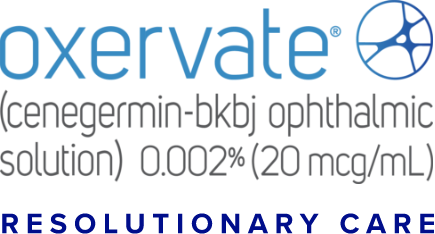
Dosing & Administration
Clinical trial results based on an 8-week course of treatment.1
Dosing
A full 8-week treatment with OXERVATE was shown to provide complete corneal healing in many patients with NK*1
Recommended dosage and dose administration1
One drop of OXERVATE in the affected eye(s),
6 times per day at 2-hour intervals, for 8 weeks1
The efficacy and safety of OXERVATE for the treatment of neurotrophic keratitis was studied in a total of 151 patients, evaluated in two 8-week, randomized, multi-center, double-masked, vehicle-controlled studies. In NGF0214, the percentage of patients with complete corneal healing at week 8 was 65.2% (15/23) in the OXERVATE arm vs 16.7% (4/24) in the vehicle arm with a treatment difference of 48.6% (95% CI: 24%, 73.1%; P<0.01). In NGF0212, the percentage of patients with complete corneal healing at week 8 was 72% (36/50) in the OXERVATE arm vs 33.3% (17/51) in the vehicle arm with a treatment difference of 38.7% (95% CI: 20.7%, 56.6%; P<0.01). Patients without any post-baseline measurements were excluded from the analysis.1
In clinical trials, complete corneal healing was defined as absence of staining of the corneal lesion and no persistent staining in the rest of the cornea at 8 weeks of treatment.1
Administration
The active ingredient in OXERVATE® is a recombinant human nerve growth factor (rhNGF)1
General dosing information1
- Contact lenses should be removed before applying OXERVATE and may be reinserted 15 minutes after administration.
- If a dose is missed, treatment should be continued as normal at the next scheduled administration.
- If more than 1 topical ophthalmic product is being used, administer the eye drops at least 15 minutes apart to avoid diluting products. Administer OXERVATE 15 minutes prior to using any eye ointment, gel, or other viscous eye drops.
Instill one drop of OXERVATE in the affected eye(s), 6 times a day at 2-hour intervals for 8 weeks.
Remove the weekly carton(s) containing OXERVATE vials from the insulated pack and store it for up to 14 days in a refrigerator (no later than 5 hours from when you receive the medicine from your pharmacy). OXERVATE is stored in a freezer at the pharmacy. If treatment is started immediately after receiving the weekly carton, wait until the first vial is thawed (this could take up to 30 minutes when kept at room temperature up to 77 °F (25 °C)). Do not shake the vial.
Watch a demo on how to administer OXERVATE
OXERVATE is supplied in an insulated pack, in weekly cartons containing 7 multiple-dose vials.1 This may include either frozen and/or refrigerated gel packs or, in some cases, dry ice.2
The OXERVATE Kit
OXERVATE is supplied in weekly cartons containing 7 multiple-dose vials1
OXERVATE is dispensed to patients in an insulated pack and co-packaged with the Delivery System Kit. The Delivery System Kit contains1:
7 vial adapters for the week
+ 1 extra adapter
42 pipettes for the week
+ 3 extra pipettes
42 sterile disinfectant wipes for the week + 3 extra wipes
1 Dose Recording Card
Storage
The OXERVATE carton should be stored in the refrigerator1
Patients should refrigerate OXERVATE as soon as possible after receiving it1
OXERVATE is supplied in an insulated pack, in weekly cartons containing 7 multiple-dose vials.1 This may include either frozen and/or refrigerated gel packs or, in some cases, dry ice.2
Pharmacy Storage1
Store the weekly cartons containing OXERVATE vials in the freezer at or below -4 ºF (-20 ºC). Dispense the weekly carton(s) containing OXERVATE vials in an insulated pack in combination with the Delivery System Kit.
Within 5 hours of delivery, store the weekly carton(s) containing OXERVATE vials in the refrigerator between 36 °F and
A vial opened for daily use may be stored in the original weekly carton in the refrigerator between 36 °F and
- Do not refreeze the vials1
- Do not shake the vials1
- Discard the opened vial after
12 hours even if there is still some solution left inside1

